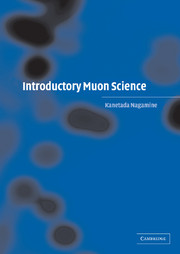Book contents
- Frontmatter
- Contents
- Preface
- List of abbreviations
- 1 What are muons? What is muon science?
- 2 Muon sources
- 3 Muons inside condensed matter
- 4 The muonic atom and its formation in matter
- 5 Muon catalyzed fusion
- 6 Muon spin rotation/relaxation/resonance: basic principles
- 7 Muon spin rotation/relaxation/resonance: probing microscopic magnetic properties
- 8 Muon spin rotation/relaxation/resonance: probing induced microscopic systems in condensed matter
- 9 Cosmic-ray muon probe for internal structure of geophysical-scale materials
- 10 Future trends in muon science
- Further reading
- Index
- References
1 - What are muons? What is muon science?
Published online by Cambridge University Press: 22 October 2009
- Frontmatter
- Contents
- Preface
- List of abbreviations
- 1 What are muons? What is muon science?
- 2 Muon sources
- 3 Muons inside condensed matter
- 4 The muonic atom and its formation in matter
- 5 Muon catalyzed fusion
- 6 Muon spin rotation/relaxation/resonance: basic principles
- 7 Muon spin rotation/relaxation/resonance: probing microscopic magnetic properties
- 8 Muon spin rotation/relaxation/resonance: probing induced microscopic systems in condensed matter
- 9 Cosmic-ray muon probe for internal structure of geophysical-scale materials
- 10 Future trends in muon science
- Further reading
- Index
- References
Summary
Scientific research using the fundamental particle known as the muon depends upon the muon's basic particle properties and also on the microscopic (atomic-level) interactions of muons with surrounding particles such as nuclei, electrons, atoms, and molecules. This chapter deals mainly with the fundamental properties of muons based on what is presently known from particle physics. Several relevant reference works exist, in particular regarding historical developments (Hughes and Kinoshita, 1977; Kinoshita, 1990).
Basic properties of the muon
In one sentence, the properties of muons can be summarized as follows:
Muons are unstable elementary particles of two charge types (positive μ+ and negative μ−) having a spin of 1/2, an unusual mass intermediate between the proton mass and the electron mass (1/9 mp, 207 me), and 2.2 µs lifetime.
Over time, a deeper understanding of the above statement has been gained through the development of experimental methods and improvements in theoretical models. Some data relevant to muon science are summarized in Table 1.1.
The uniqueness of lifetime and mass can be understood by comparing muon values to those of other particles, as seen in Figure 1.1. These properties can be summarized as follows:
The muon has the second longest lifetime among all the fundamental unstable particles (that is, omitting particles believed to be stable, such as the proton, electron, and neutrino) after the neutron, and has the second smallest mass among all the fundamental particles after the electron.
The following paragraphs elaborate and clarify the contents of Table 1.1.
- Type
- Chapter
- Information
- Introductory Muon Science , pp. 1 - 16Publisher: Cambridge University PressPrint publication year: 2003
References
- 3
- Cited by



